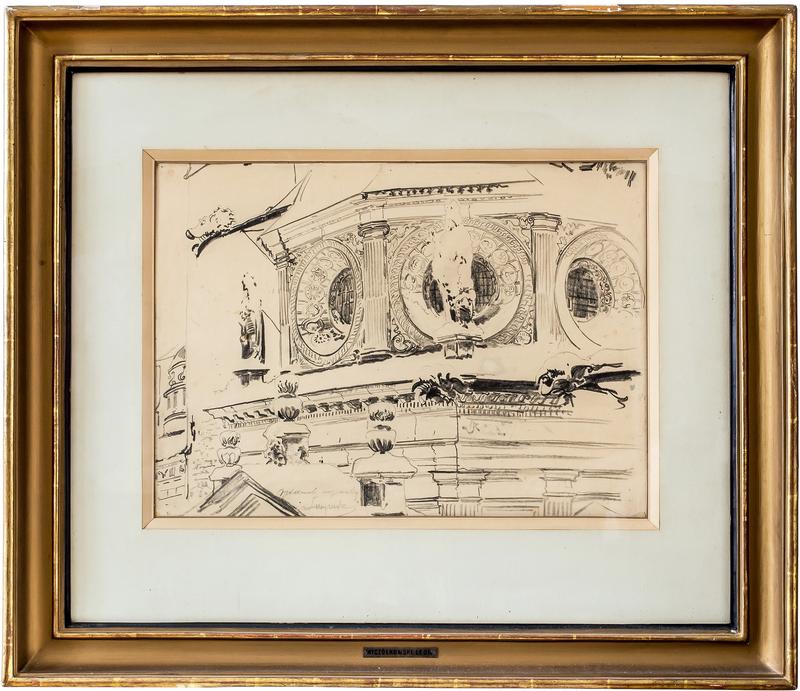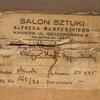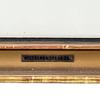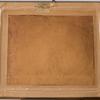Description:
This painting has a certificate confirming its authenticity issued by DESA Dzieła Sztuki i Antyki Sp. z o. o.
Biography:
Leon Jan Wyczółkowski of the Ślepowron coat of arms (born April 11, 1852 in Huta Miastkowska, died December 27, 1936 in Warsaw). Wyczółkowski is one of the most outstanding artists of the Young Poland period. He was an excellent painter, graphic artist, and a long-time teacher. He attended the Warsaw Drawing Class in 1869-1875. His professors were Wojciech Gerson and Aleksander Kamiński. He also expanded his knowledge at the Academy of Fine Arts in Munich under the supervision of Alexander Wagner and in Paris and Kraków (with Jan Matejko at the School of Fine Arts in 1877-1879). He traveled to Italy, France, the Netherlands, England and Ukraine. In Lviv he became friends with A. Chmielowski. From 1895 he lived in Krakow, where he became a lecturer at the School of Fine Arts (he was a professor at the Krakow university in the years 1895-1911). He also headed the department of graphics at the Academy of Fine Arts in Warsaw (since 1934). In Paris he became acquainted with impressionism. He was also inspired by colorism and symbolism. Initially, the subject of his paintings were historical and genre scenes, then portraits and drawing room scenes. He painted landscapes (mainly Tatra Mountains), still lifes, architectural monuments, and flowers. In his painting, the artist showed a sentimental attitude to nature and interest in native themes. Wyczółkowski worked in oil, watercolor and pastel, and was also involved in sculpture and graphics (since 1918). In graphics, he used etching techniques, autolithography, and a variety of formal solutions (his works include thematic portfolios, e.g. "Tatra Mountains", "Old Warsaw"). The artist was one of the founders of the Society of Polish Artists "Sztuka" and participated in almost all of its exhibitions. Wyczółkowski received the Golden Cross of Merit and other artistic distinctions.
Fascination with lithography
Around 1900, Wyczółkowski's fascination with original graphics began for over thirty years. The first attempts, encouraged by Feliks Jasieński, a connoisseur and collector of European graphics, were made by the artist using techniques closely related to painting - color oleolithography and algraphy. In the field of etching, he was provided with technical advice and support by the master of reproductive etching - Ignacy Łopieński, the owner of the first press in Warsaw and the only one that the Poles had at their disposal at that time, unquestioned by the Russian authorities. As a professor at the Krakow Academy of Fine Arts from 1902, Wyczółkowski conducted constant experiments in the field of graphic techniques; he found the widest possibilities of artistic expression in the technique of lithography. The creator's fascination with this graphic medium, which lasted over a quarter of a century, was preceded by numerous attempts in etching, aquatint, fluorofort and soft varnish. Wyczółkowski's graphic portfolios, including: "Mixed portfolio" (1904), "Lithuanian portfolio" (1907), "Gdańsk" (1909), "Hutsul portfolio" (1910), "Wawel I. II." (1911/12), "Ukrainian Portfolio" (1912), "Kraków" (1915) and "Stara Warszawa" (1915), contained mainly autolithography, sometimes combined with fluorographs and autoalgraphy. Wyczółkowski's lithography evolved over time and underwent formal transformations; the artist changed the way he used black chalk, moved it sideways to obtain halftones and soft shapes, drew it sharply to intensify the precise contour, and added ink to deepen the shadows. Wyczółkowski, called the father of modern Polish lithography, became an unrivaled record holder in Poland as the creator of fifteen graphic portfolios. Wyczółkowski drew city landscapes with the same panache as the vast landscapes of Lithuania and Ukraine. In 1909, the artist published his first portfolio, which consisted exclusively of architectural motifs; these were views of Gdańsk recorded with a skillful stroke of a crayon, perceived with the eye of a realist, sensitive to the variability of valuable tones. The creator was not afraid of radical fragmentation of shots - he did not hesitate to suspend the dome of the town hall tower and the roofs of tenement houses in the optical vacuum created by the whiteness of the board, depriving them of a solid, architectural support (Town Hall - Tower, 1909). The silhouette of the Church of the Virgin Mary, bristling with soaring towers, closing the street, seems to be an ethereal curtain in Wyczółkowski's autolithography (The Church of the Virgin Mary, 1909). By "portraiting" Polish cities, Gdańsk, old Krakow and Warsaw, the artist showed architectural monuments recalling the nation's past. Wawel was a treasure trove of national memorabilia and a symbol of the former power of Polish statehood; In his lithographs, Wyczółkowski was able to transform its powerful silhouette, seen from Stradom, Zwierzyniec, and Starowiślna Street, into a phenomenal castle. In both Wawel portfolios (1911/12), the artist immortalized the most valuable fragments of Wawel architecture for national memory - the cathedral, Kurza Stopka, the Sigismund Chapel and the most symbolically significant royal tombstones of Jadwiga, Jagiełło and Casimir Jagiellon. Wyczółkowski abandoned the previous sketchiness of the approach in favor of a more refined and decorative style, restored the descriptive function of lines, combined slender, thin lines, tense like strings, with soft, winding lines that nimbly change their course; he complemented his ascetic, black and white scale of values with a narrow, harmonized range of colors. The Kraków portfolio (1915) also had a patriotic message; here, luministic effects intensify the atmosphere of reflection on the passage of time in the dimension of individual existence and national existence. The appearance of Warsaw during the war was commemorated by Wyczółkowski - "trapped" in the capital as a result of war operations - in the portfolio "Old Warsaw" (1915). He was particularly attracted by the picturesquely layered shapes of the roofs of the Old Town, which he observed closely from the dormitory window (via culture.pl).
Wawel
The artist's historical awareness - inherited from the Romantics and Matejko - found expression in his works showing the architectural grandeur and beauty of the Polish Acropolis - Wawel. From the time he lived in Krakow, he was fascinated by Wawel. The artist himself admitted that he started painting the Wawel Cathedral in 1895. First, he created Sarcophagi. And here let us give the floor to Ludwik Puget, who revealed the background of the creation of this composition, writing: "[...]He came up with incredible ideas. He wanted to paint royal sarcophagi. First, he sculpted them in life-size plaster, greased them, covered them with dust, covered them with cobwebs, and only then painted his own sculpture on canvas. He wanted to! He had enough imagination and willingness to go to all this trouble. This concept came to his mind, he had fun getting a taste of the sculptor, he didn't tell himself that it was a waste of time and effort, that during this time he could have painted four more portraits or other paintings that were already well paid at that time...'' In 1907, a valuable series was created the pastel "Wawel Treasury", presenting objects commonly considered to be national relics. The total number consisted of 17 paintings. This is the only series of the artist's pastel works preserved in their entirety to this day. The portfolio of lithography "Wawel", dated 1911/1912 with fifteen works, became a wonderfully composed graphic hymn to the dignity and charm of the royal hill. The appearance of the "Wawel" portfolio was not only a testimony of admiration for the symbol of Polish statehood in the absence of it, a demonstration of the architectural beauty of the Wawel Hill buildings, but also a demonstration of all the techniques discovered and constantly improved by the artist himself. The artist made a significant number of images of Krakow and its monuments. Each time he looked for interesting viewpoints. He dedicated the work "Wawel from Starowiślna Street" to the silhouette of Wawel itself. He also painted several watercolors depicting panoramas, churches, the Kościuszko Mound and the Cloth Hall (View from Wawel). Lithographs were also created, the most interesting of which were included in the "Jubilee Portfolio of the Church of Our Lady in Krakow".
Vasa Chapel - architecture and external appearance
The Vasa Chapel, built in the second half of the 17th century, is located in the southern nave of the Wawel Cathedral. From the outside, it is almost a copy of the Sigismund Chapel and is often compared with it. In accordance with the will of Sigismund III Vasa, the chapel - founded by King John Casimir - became the family mausoleum. Epitaphs of all male descendants of the Polish Vasa line were embedded on the walls. The building - covered with a dome with a lantern, supported by an octagonal drum set on a square plan - was made of ashlars. The façade consists of a high plinth with fluted Tuscan pilasters. The entablature is supported on them. The space between the pilasters is divided into three sections, which are filled with rhombus-shaped boards (upper and lower sections) and a rounded rectangle with inscribed dedications (middle sections). The exception to this arrangement is the southern facade, where in the upper section of the central field between the pilasters there is a cartouche with the coats of arms (from the outside) of Poland and Lithuania, Sweden and the Vasa family, surrounded by a chain of the Order of the Golden Fleece, topped with a crown (corona clausa type). On the pedestals in the upper corners there are figures of Saint. Sigismund (southwest corner) and St. Władysław (south-east corner). There are fluted Ionic pilasters in the corners of the tambour. The field between them is filled with circular windows. In this architectural part, there is a bas-relief decoration depicting motifs of angel heads, dragons, flowers and crossed shields. The dome is covered with copper sheets. There is an octagonal lantern with pilasters on it, and the whole is closed by a dome with a cross.
Description
This autolithography was created around 1915 and shows a fragment of the Vasa Chapel on Wawel Hill. The artist sketchily, yet suggestively, conveyed the character of this pearl of architecture, thanks to which the building appears to us as both monumental and airy. The seemingly random composition shows some of the most interesting architectural details of this building. Seemingly, because the desire to capture the mood and fleeting beauty of a moment is combined in his works with an attachment to a clear form. Wyczółkowski was not afraid of radical fragmentation of approaches, as this work is an example of. The chapel was shown in a fragmentary way (as if in a frame) from the south-eastern side below the dome. In many of Wyczółkowski's architectural works, the iron compositional principle is the division into plans and the presence of a main motif. The main motif here is the tambour (drum) with phenomenal circular windows, subtle decorative reliefs and fluted Ionic pilasters, as well as decorative gutters (gargoyles) and figures of Saint. Sigismund (southwest corner) and St. Władysław (south-east corner). The artist differentiates the plans here using a contour. He added ink to the precise contour in some places to deepen the shadows. The shape of the chapel and the decorative cornices are marked with a strong line and a clear contour, and the fragment of the Silver Bell Tower and the Potocki Chapel (second plan) are drawn with a light and delicate line. This work is characterized by masterful use of soft chalk, deft transition of an agile line into a dynamically placed patch of velvety black. Architectural details were rendered perfectly. Looking at this work, there is no doubt that Leon Wyczółkowski has achieved a truly virtuoso level in the lithography technique.
Parameters and state of preservation
Autolithography on paper. Dimensions: 48.5x35.5 cm (in passe-partout). Dimensions including frame: 77.5x67. The work is behind glass, framed in an old, gilded wooden frame. Hand-signed in pencil ld: "original drawing" (collector's inscription) / "L. Wyczół" (original, author's signature). On the reverse there is a paper sticker from the Alfred Wawrzecki Art Salon in Krakow from 1934. The inscriptions on the sticker are: Author: Leon Wyczółkowski | Title: Fragment. Kapl. Zygmuntowska (antiquarian's mistake) | Type: pencil | Size: 50x35 | No. Corner. 160/38. Moreover, on the back there is a probably pre-war stamp (partially covered) of the Krakow Provincial Office ... (illegible) art (?), and a handwritten number: 7-12-k-36. Moreover, there is an inscription in pencil on the back: "Wawel Chapel of the Vasas". At the bottom of the frame there is a tarnished brass plaque with the inscription: "Wyczółkowski Leon".
The condition of the lithography is very good, but the frame has some defects and cracks - visible in the photos.
Parameters:
Dimensions: Dimensions: 48.5x35.5 cm (in passe-partout).
Signature: Signed in pencil ld: "original drawing /L. Wyczół"
Support material: Autolithography on paper
Delivery and payment: 
Report a violation







